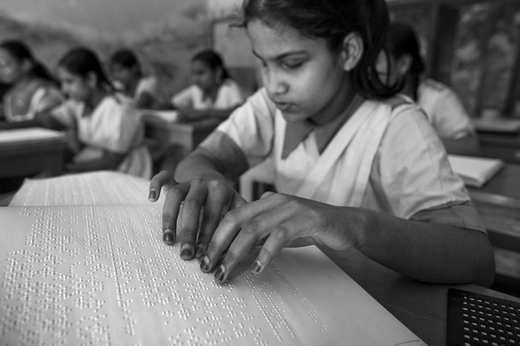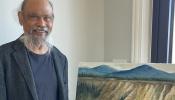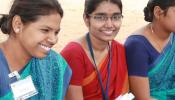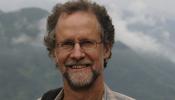By Janet Smith,
Originally Published April 24, 2012 in the Georgia Straight
Amid Larry Louie’s moodily atmospheric black-and-white images is a picture of a young girl running her fingers over a big sheet of Braille at a desk. Like so many of his photos from around the world, it displays deep empathy for its subject—and hints at the moving stories he heard while visiting a school for the blind in Bangladesh.
Reaching for a Dream is one of the photographs displayed in Beyond the Darkness
While Louie has a great appreciation for sight because he is a documentary photographer, that’s heightened by the fact that he is also a working optometrist.
“Dhaka is a city of 15 million people, with 80 percent below the poverty line, so there are a lot of desperate people there—not that they’re unhappy, necessarily, but they don’t have a lot of things we take for granted, like food, water, electricity,” Louie explains, recounting the story behind the image Reaching for a Dream, one of 23 of his photos showing in Beyond the Darkness, at the HSBC Pendulum Gallery to mark Seva Canada’s 30th anniversary. He’s speaking to the Straight over the phone from a very different world, his busy optometry practice in Edmonton, where he’s just seen his last patient of the day.
“It’s overcrowded, it’s dirty—and it’s hard enough if you’re sighted. If you’re unsighted, it’s even worse,” he continues. “And with some of these girls, it’s one thing to be born blind and say, ‘I’m not sighted,’ but it’s another when a girl is sighted and gets blinded in an instant because of a jealous boyfriend who has thrown acid in her face. Imagine what it is to lose your sight in a split second when you’re sighted and you depend on your eyes your whole life. And imagine having to be able to survive in a country with no infrastructure or support.”
With his photos, Louie has been able to raise awareness about social and health issues around the world, but particularly about the need to end blindness. Seva, based in Vancouver, has restored sight to about 3 million of the world’s poorest people since 1982, often simply with glasses or a 10-minute cataract operation. Louie has travelled with the group to several of its key projects. In his show here, Louie has chosen 23 of his favourite works, some themed around sight, but others just celebrating the beauty he finds amid the far-flung developing destinations he sees: there’s the image of birds fluttering around a temple in the middle of noisy Kathmandu, or the unearthly Djenne Mosque towering over a man in a white robe in Mali.
As a young man experimenting with his camera, Louie once dreamed of becoming a professional photographer for National Geographic. But his parents encouraged him to seek a degree in the medical profession.
“Being traditional Chinese, my parents wanted me to have a formal education. And I thought optometry would be a great match,” Louie says.
He went on to start his own practice, but maintained his love of travel photography. About seven years ago, things came full circle when his wife entered one of his shots in a National Geographic competition and it took second place. That was when Seva took notice. And so he struck up a partnership: he would join the group abroad, sometimes doing eye work, but mostly documenting their projects with his ethereal black-and-white shots. Along the way, he would witness uncountable men, women, and children getting their vision restored.
“When you see a person that can’t see well and they get treatment and all of a sudden they can see, it’s very touching and you just want to help more”
These days, Louie splits his time between traveling with Seva and other groups, and hitting the road on his own with his wife. They just got back from Nepal, his favourite destination (and a country where Seva also does a lot of work). “Kathmandu, especially, is my favourite to shoot in: it’s a vibrant city, with lots of interesting things to see—not just for tourists. The great thing about Nepal is the harmony between the three major religions of the world—Buddhism, Hinduism, and Islam tend to live in harmony. Kathmandu itself is going through lots of growing pains—people are moving from outer areas into the promised land of the city and unfortunately it is bursting at the seams. There is not enough water or electricity, and there are a lot of slums. There are a lot of social issues that are happening, which as a regular tourist you wouldn’t see. But if you actually go there and spend time in non-tourist parts, you see the painful things going on. I like to shoot things like that that have social messages.”
On his most recent trip to Nepal, he was shooting for London-based Oxfam, and focusing for the first time on the grim state of maternal health care in the developing world. The trip took him into remote parts of the country, where he was staying in tents and shacks and sterilizing his own water. And as so often happens on his journeys, he found himself personally involved in one of the more heart-breaking cases. Call it a hazard of the job, but one he wouldn’t have any other way.
“We met a family that was devastated. The mother had passed away because they couldn’t find a doctor,” he relates. “So there was no breastfeeding and the babies were drinking cows’ milk diluted with bad water. So these babies were very small. After leaving there, we felt very bad because we wanted to help them. We decided we wanted to buy them formula, but have you ever tried to find formula in a Third World country? My wife took three hours to find it and have it shipped over to their village.”
The stories he witnesses are different from Africa to Nepal to Tanzania, but many of the themes are the same—and they’re motifs that come through vividly in his photographs. Through his extensive travels (usually two big trips per year) Louie has become staggeringly aware of the impact of globalization and urbanization on people, and also on the loss of indigenous cultures.
Perhaps most interestingly of all, Louie has unwaveringly stuck with printing his photos in black and white—a choice that at first might seem at odds with the fact he’s so interested in sight. But other than the fact that he prefers its gritty, documentary feel, his choice speaks to his very deep understanding of the eye.
“I love colour, don’t get me wrong, but I want to portray my photography as lighting,” he says, adding, “and light is one of the most important things in vision as well.”



